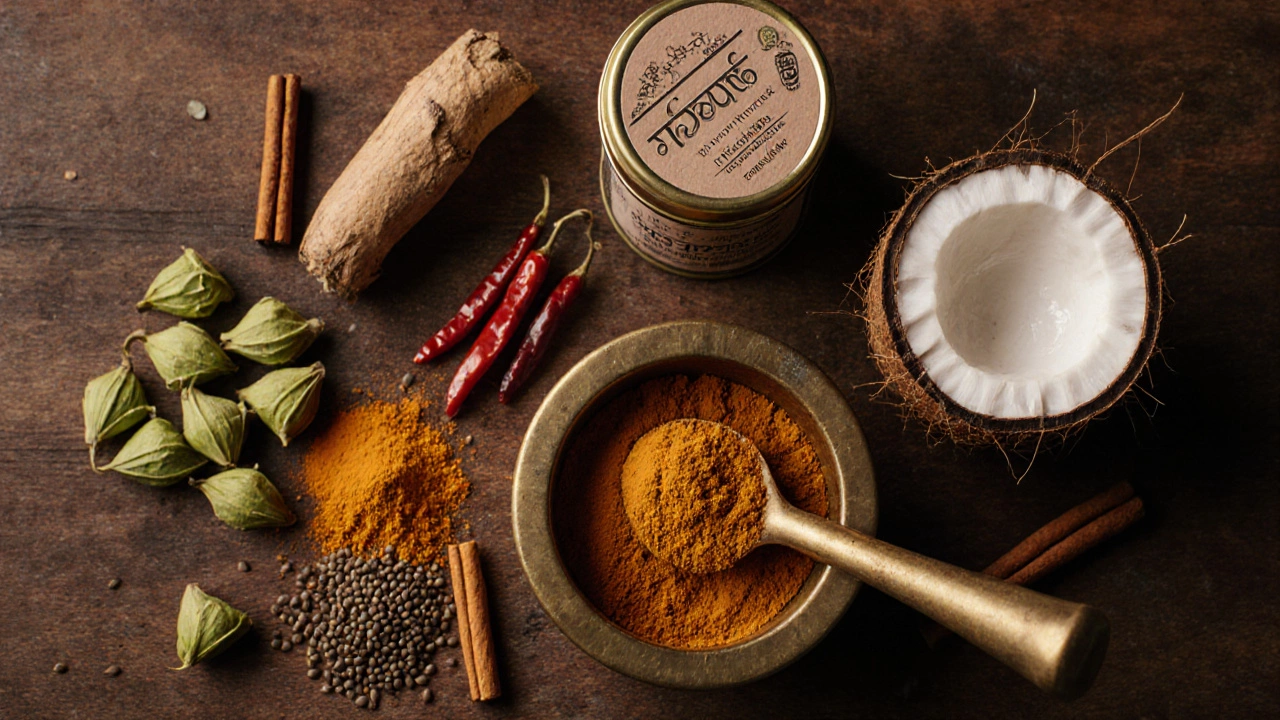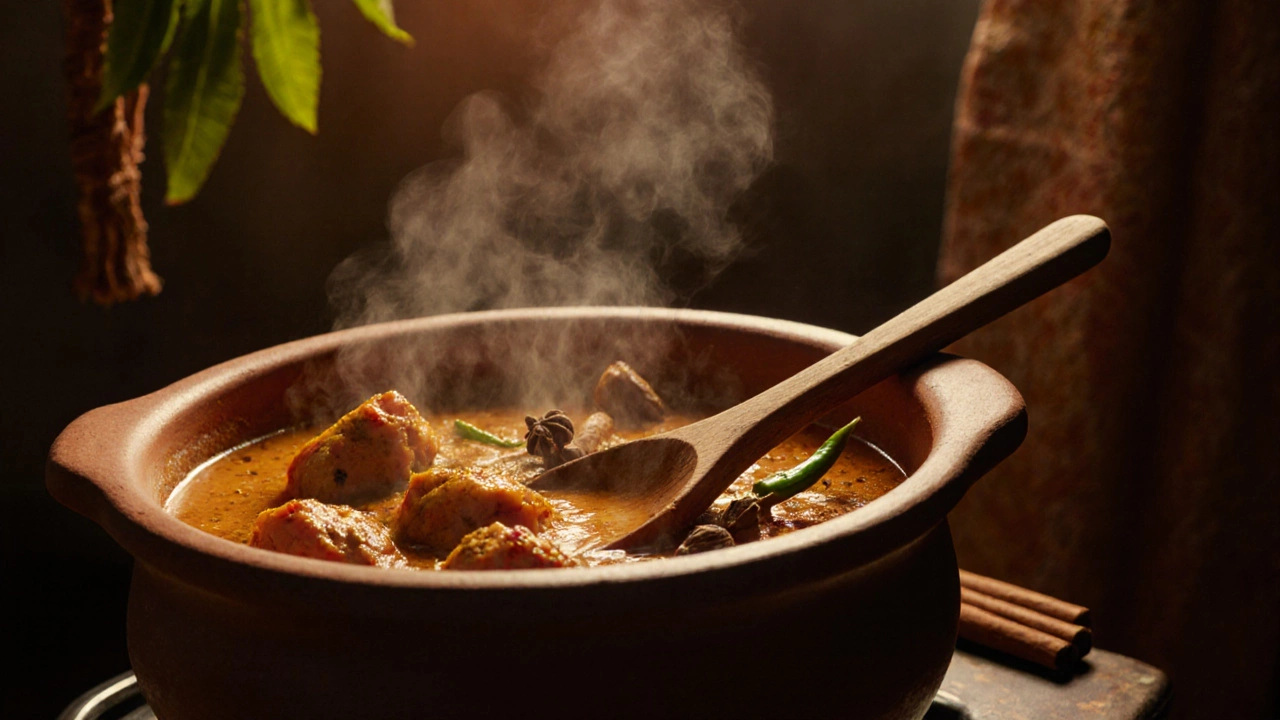What Are the Most Common Ingredients in Curry?
17 November 2025

Curry Spice Ratio Calculator
Calculate the perfect spice ratios for authentic curry based on your preferred heat level and liquid base. This tool uses the core principles from the article to help you achieve restaurant-quality results.
Recommended Spice Ratios
Core spices for heat level:
Turmeric:
Cumin:
Coriander:
Pro tip: Toast whole cumin and coriander seeds for 30 seconds before grinding for maximum flavor.
Ever open a jar of curry powder and wonder what’s actually inside? Or maybe you’ve made chicken curry a dozen times, but it never tastes quite like the one at your favorite restaurant. The truth is, curry isn’t one thing. It’s a mosaic of flavors built from a handful of core ingredients that show up again and again - whether you’re cooking in a Mumbai kitchen or a suburban apartment in Chicago.
Curry Starts With A Base
Every great curry begins with the same three ingredients: onions, garlic, and ginger. These aren’t just flavor boosters - they’re the foundation. When you cook them slowly in oil or ghee until they turn golden, they break down into a sweet, aromatic paste that clings to the chicken and carries every other spice. Skip this step, and your curry will taste flat, no matter how much powder you dump in.
Some cooks skip the fresh ginger and use powdered ginger instead. Don’t. Fresh ginger has a bright, peppery kick that powdered ginger just can’t match. The same goes for garlic - roasted garlic gives depth, raw garlic gives bite. Use both if you want complexity.
The Spice Core: Turmeric, Cumin, Coriander
If you remember only three spices, make them turmeric, cumin, and coriander. These are the holy trinity of Indian curries. Turmeric gives the golden color and a warm, earthy bitterness. Cumin adds a smoky, nutty depth - it’s the backbone of most chicken curries. Coriander seed, ground, brings a citrusy, slightly floral note that ties everything together.
Most store-bought curry powders have these three, but they’re often diluted with fillers like flour or paprika. For real flavor, toast whole cumin and coriander seeds in a dry pan for 30 seconds before grinding them. You’ll taste the difference immediately. Freshly ground spices lose their punch after two months, so buy small amounts and grind as needed.
Heat Comes From Chili - But Not Always Powder
Curry isn’t about burning your tongue. It’s about balance. Dried red chilies - whole or crushed - are the most common source of heat in traditional chicken curry. You can fry them in oil at the start to release their flavor without making the dish too spicy. Kashmiri red chilies are popular because they give rich color with mild heat. If you want more punch, add a chopped green chili or two at the end.
Many recipes call for chili powder, but that’s often just ground dried chilies with added salt or filler. If you’re using it, check the label. Pure chili powder should list only one ingredient: chilies. If you see ‘spices’ or ‘cayenne’ mixed in, you’re not getting pure heat - you’re getting a blend that changes the flavor.

Cardamom, Cinnamon, Clove: The Warmth Layer
Here’s where many home cooks go wrong. They think curry is just about heat and earthiness. But the magic happens when you add warmth. Green cardamom pods, a stick of cinnamon, and a few cloves - these are the unsung heroes. They don’t dominate. They linger.
These spices are usually added whole at the beginning, fried in oil until they crackle. That’s when their oils bloom and fill the kitchen with that unmistakable curry scent. Remove them before serving, or leave them in if you like a little surprise in your bite. Don’t grind them. Their power is in their whole form.
Some regional curries use star anise or fennel seeds. That’s fine, but stick to the core five - cardamom, cinnamon, clove, cumin, coriander - before experimenting. Too many spices at once just makes noise.
Tomatoes and Coconut: The Liquid Backbone
Curry needs liquid, and that liquid changes the whole character of the dish. In North Indian chicken curries, tomatoes are the go-to. Cooked down until they collapse into a thick sauce, they add acidity, sweetness, and body. Canned crushed tomatoes work fine, but fresh ones, peeled and simmered, give better control over flavor.
In South Indian or coastal curries, coconut milk or grated coconut is the base. It turns the curry creamy, rich, and slightly sweet. If you use canned coconut milk, shake the can first - the thick cream separates and rises to the top. Use the cream for richness, the thinner liquid for volume.
Some recipes use yogurt. That’s great for tenderizing chicken and adding tang. But don’t add it cold. Stir it in off the heat, or it’ll curdle. A spoonful of tamarind paste is another classic souring agent - it’s like a natural lemon, but deeper.
Final Touches: Fenugreek, Mustard Seeds, and Curry Leaves
These are the details that separate good curry from unforgettable curry. Fenugreek seeds - tiny, bitter, and aromatic - are often dry-roasted and ground into a powder. A pinch goes a long way. It adds a maple-like bitterness that balances sweetness and fat.
Mustard seeds, especially black ones, pop in hot oil like popcorn. That’s your signal to add the next ingredient. They give a sharp, nutty crunch. Curry leaves - fresh, not dried - are non-negotiable in South Indian curries. Fry them in oil until they crisp slightly. Their citrusy, herbal scent is the smell of authentic curry.
Dried curry leaves are almost useless. If you can’t find fresh ones at your local Indian grocery, order them online. They’re cheap, last weeks in the fridge, and make a huge difference.

What’s Missing? The Secret Ingredient
There’s one thing almost every home cook forgets: time. Curry isn’t rushed. It needs at least 30 minutes of slow simmering after you add the chicken. That’s when the spices settle into the meat, the sauce thickens, and the flavors marry. Stirring too much breaks the sauce. Let it rest.
And if you want to go pro? Make your curry the day before. Refrigerate it overnight. The fat hardens on top - skim it off. Then reheat. The flavors deepen, the texture smooths out. It’s not magic. It’s chemistry.
Common Mistakes to Avoid
- Adding spices at the end - they won’t bloom, and they’ll taste raw.
- Using pre-ground spices older than six months - they’ve lost their oils.
- Boiling the curry too hard - it breaks the sauce and makes the chicken tough.
- Skipping the onion-garlic-ginger base - you’re skipping the soul of the dish.
- Using water instead of broth or coconut milk - water dilutes flavor, it doesn’t enhance it.
Simple Chicken Curry Formula
Here’s a no-fail structure you can use every time:
- Heat 2 tbsp oil or ghee. Add 1 tsp mustard seeds, 10 fresh curry leaves. Wait until they sizzle.
- Add 1 chopped onion. Cook until golden. Add 2 tbsp minced ginger and 3 minced garlic cloves. Cook 2 minutes.
- Add 1 tbsp ground turmeric, 1 tbsp ground cumin, 1 tbsp ground coriander. Stir 30 seconds.
- Add 2 chopped tomatoes. Cook until mushy, about 8 minutes.
- Add 1 lb chicken pieces. Coat in spice mix. Cook 5 minutes.
- Pour in 1 cup coconut milk or 1.5 cups chicken broth. Add 1 green chili, 2 cardamom pods, 1 cinnamon stick, 3 cloves. Simmer 25 minutes.
- Stir in 1 tsp fenugreek powder. Taste. Add salt. Let sit 10 minutes before serving.
That’s it. No fancy tools. No exotic ingredients you can’t find. Just the basics, done right.
What’s the difference between curry powder and curry paste?
Curry powder is a dry blend of ground spices - usually turmeric, cumin, coriander, chili, and sometimes fenugreek or cardamom. It’s shelf-stable and used in dry-rub or sauce-based curries. Curry paste is wet, made by grinding fresh ingredients like ginger, garlic, chilies, and herbs with oil or water. Thai red curry paste, for example, contains lemongrass and kaffir lime leaves. They’re not interchangeable - curry paste adds freshness and texture, while curry powder adds concentrated spice.
Can I use garam masala instead of individual spices?
Garam masala is a finishing spice blend - usually cinnamon, cardamom, cloves, cumin, and black pepper. It’s added at the end to brighten the dish. It’s not a substitute for the base spices like turmeric or coriander. If you use only garam masala, your curry will lack depth and color. Think of it like adding salt at the end of cooking - it enhances, but doesn’t build flavor.
Why does my curry taste bitter?
Bitterness usually comes from burnt spices or too much fenugreek. If you cook the spices on high heat without oil, they burn quickly and turn bitter. Always toast them gently in fat. Fenugreek has a strong, maple-like bitterness - use no more than 1 teaspoon per pound of chicken. If you’ve already added too much, stir in a pinch of sugar or a splash of cream to balance it.
What if I don’t have fresh curry leaves?
Fresh curry leaves are irreplaceable for authentic flavor. If you can’t find them, skip them. Don’t substitute with bay leaves or dried curry leaves - they don’t taste the same. Bay leaves are more medicinal, and dried curry leaves lose 90% of their aroma. Your curry won’t be wrong without them, but it won’t be fully right either. Order fresh ones online - they ship well and last weeks in the fridge.
Is chicken curry healthy?
Yes, if you make it right. Turmeric has anti-inflammatory properties, garlic supports immunity, and chicken is lean protein. The real issue is oil and cream. Traditional recipes use ghee or coconut milk, which are high in fat. To make it healthier, use less oil, swap coconut milk for light coconut milk or yogurt, and skip the cream. Add more vegetables like spinach or cauliflower to bulk it up. It’s still flavorful, just lighter.